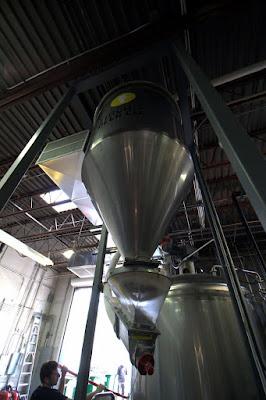I went to a BBQ at Finch's Brewery a few weeks ago at 4565 N. Elston. Afterwards I asked one of the owners if I could photograph his brewery and oddly enough he said yes. And that's why small companies rule. This is the digital portion of the results.
The warehouse was really nicely done. I've been in a lot of factories so I have a fairly good idea of what a good fit and finish looks like industrially. These guys spent some money up front and ended up with a really nice place. They're busy too. The day I was there they had about six or seven employees working - it didn't hurt that they were all really nice and entertained my usual battery of questions.
This is their main room where all cooking and fermenting happens.

Keg washer. The kegs get rinsed with pressurized acid to eat away any build up, then iodine to sterilize them, and (if I remember all this right) are finally rinsed with water. This same station handles keg filling.

After being washed the kegs are stored in the fridge to get the ready to be filled.

Beer making is at least 50% sterilizing everything. Hence, there's sterilizer everywhere.

This is the grain grinder.

It has it's own dedicated room (Update: this is supposedly because grinding grain causes a fine dust to accumulate in the air that becomes an explosion hazard).

Their milled grain connects directly to a silo via a system very similar to those vacuum tubes used at banks. I'm not actually sure what mechanisms move the grain around. I'm assuming an auger attached to a motor.

The silo sits right next to what I'm going to call the cooking station.

Cooking station. Update: The vessel on the left is a boil kettle where the wort is boiled to the desired gravity. The one on the right is a combination mash/lauter tun where the grains steep in water to extract their starches (sugar).

This is a PLC (programmable logic controller) LCD screen. Everything is automated - it's incredible how similar this is to the concrete plants I work at - the output here is just more interesting.



No open flames at Finch's hence the steam boiler. Never seen one of those before...

This is a heat exchanger that removes heat from the freshly brewed wort (pre-beer) so that yeast can be pitched. This is a much bigger version of the tiny copper coil that Evan and I use to chill our massive 5 gallon batches. Finch's does a 1000 gallons at a time. If you don't cool it down the yeast will die and fermentation will never start - at least not with the bacteria that you want. I think they run city water through this then chilled glycol (more on that in a bit). I think I'd increase my surface area and lower my delta T (city water is pretty cheap) but they seem to have their system pretty well worked out.

The grain needs to get cleaned out of the mash/lauter tun. A tad bigger than our 3 gallon stock pot.
These are their 1000 gallon fermenters where their beer will sit for several weeks.

The yeast gives off CO2 as it converts sugar into alcohol, but air cannot be allowed back into the fermenter. Hence, an air lock. In this case a 5 gallon bucket filled with sanitizer. This one was really bubbling off.
These are 5 gallon kegs that I would normally help Evan fill with beer. In this case this is what they use to hold their yeast. 5 gallons of yeast to 1000 gallons of beer! They propagate all their own yeast.

That's a food grade hose. Everything is stainless, seamless, and sterilized.


This is part of their glycol system. The fermenters are jacketed. That is, double walled. Chilled glycol is circulated around them to keep them at whatever temperature is wanted.

Glycol supply and return lines


A solenoid and control precisely control the temperature.

This is the reservoir/make-up tank for the glycol. As you might be able to tell from the number of photos I was really impressed by this system.

Once fermenting is done the beer can be either bottled or put into kegs. This is the canning line.


If the beer is to be kegged it makes its way to the manifold (bottom). All the fermenting tanks connect to this. Very nice. Much easier to open a valve and let gravity and pumps do the work.







3 comments:
Logan, sweet pics buddy. How was thier beer?
So the reason the grain mill is stored in a separate room is due to the explosion hazards associated with milling grain. Grain produces a very fine dust which can ignite and cause a serious explosion with just a small spark.
As for the "cooking station", the vessel with the manway (hatch)is a combo mash/lauter tun. Thats where the grain will steep extracting the starches (sugars) and activate the enzymes needed for this extraction. The other vessel is the boil kettle, used to boil the wort effectively concentrating it to achieve the desired gravity.
again cool pics man
cheers!
andrew
Thank you.
Nice pics. I am good friends with the brewers there and visit often. Your photos are the nicest I have seen of the place yet.
Post a Comment